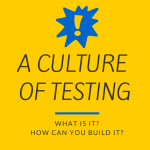What does it mean to create an organizational culture of testing? We’ve gone over what A/B testing means and how you can try it out on everything from email subject lines to Facebook headlines. But there’s a difference between trying a few tests and changing the culture around testing for your campaigns. We think the difference comes down to creating a culture of testing.
What does that mean, and who came up with it? Daniel Mintz over at Upworthy is responsible for coining the phrase. Upworthy has a legendary commitment to testing their own content (they’re on record as testing 25 headlines for all of their content!).
What does a culture of testing mean, and how do you build one in your own organization? First, a culture of testing means a commitment to doing your work in a way that allows you to measure the outcomes. Work becomes measureable when you track the relevant metrics. For emails, the relevant metrics are the open rate, the click rate, the action rate, and the unsubscribe rate. For action pages, the metric is the conversion rate: the number of people who take the action after visiting your page. There are a variety of ways to track metrics and we’ll talk more about some of them below.
Second, a culture of testing also means being data-driven in your decision making. You might end up getting results that seem counter-intuitive or that weren’t the option you liked the best. But you gotta use what works! For more about this, check out our breakdown of A/B testing (with gifs!).
How do you get started creating a culture of testing?
- Get buy-in across your organization. Make sure that everyone understands why you’re sending out two different versions of an email headline. Testing builds the effectiveness of your campaign by showing you what your target audience actually responds to rather than speculating about what they might respond to. Make sure everyone is onboard with that idea!
- Run at least one test for every campaign you do. Make sure that testing is a routine aspect of your campaigns. Regular testing means a greater understanding of your audience and your message. You can build on your knowledge with each campaign.
- Start simple. Email subject lines and Facebook headlines are a fast, easy way to gauge message effectiveness. Try just one variation to test for your first campaign and build up from there.
- Schedule check-ins about what you’ve learned. Talk to your team about what lessons you’ve learned from testing. Does your audience respond best to a straight-forward “Sign this petition!” headline? Are they more likely to open an email with a question in the subject line? Share those insights with your team.
Now that you’re ready to build up a culture of testing within your organization, you might need some tools to get started. Here are a few ways to A/B test and track metrics for your campaigns:
- Emails: Most CRMs have a built-in A/B testing feature that will allow you to test out different email options.
- Webpage A/B testing: Try out Google Website Optimizer or Optimizely
- Social media: Maybe you’ve heard of ShareProgress?
Good luck getting your culture of testing off the ground! Let us know in the comments if you have any other tools or tricks to share.

Comments